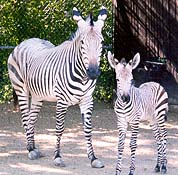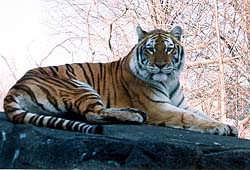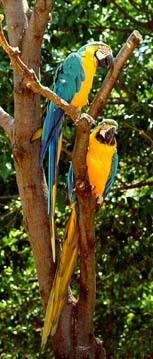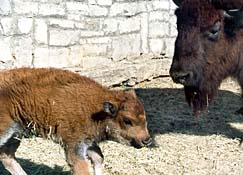
![]()
Doing Our Part to Save Endangered Species
The zoo does more than just house and feed animals. The Henry Vilas Zoo also helps to save endangered animals through the Species Survival Plan (SSP), which is run by the American Zoological and Aquarium Association.
 The
Species Survival Plan, which began in 1981, seeks to increase the numbers
of endangered species while reducing the amount of inbreeding. In some
cases an SSP's goal is to reintroduce captive animals back into the wild.
The
Species Survival Plan, which began in 1981, seeks to increase the numbers
of endangered species while reducing the amount of inbreeding. In some
cases an SSP's goal is to reintroduce captive animals back into the wild.
SSPs keep careful records of animal's genetic make-up, their lineage, and where they came from. When breeding, SSP officials try to match up mating couples that are genetically diverse. This helps keep the species' gene pool as large as possible, which lowers the animal's genetic defects, infant mortality rate, and susceptibility to diseases.
 |
Our zoo participates in 16 of the AZA's 86 Species Survival Plans, including plans for the Siberian Tiger, White Rhinoceros, and the Orangutan. Under one SSP the zoo has recently received a female tiger which it hopes to breed with our male tiger. |
In some cases, zoos participate in SSPs by lending animals to other zoos. The Henry Vilas Zoo is currently lending a Palm Cockatoo to Sea World in Florida, and a Cotton-Topped Tamarin to the St. Augustine Alligator Farm, in St. Augustine, Fla. In return, other zoos lend animals to our zoo, such as our new female tiger named Rika, which came from the Ellen Trout Zoo in Lufkin, Texas. But zoos that participate in SSPs take care not to breed animals if there is no room to properly house them.
 Participating
in the SSPs allows the zoo to gain valuable animal information from other
SSP participants, according to Jeff Stafford, Henry Vilas Zoo supervisor.
Our zoo may not otherwise get advice about the animals' health care and
breeding, he said.
Participating
in the SSPs allows the zoo to gain valuable animal information from other
SSP participants, according to Jeff Stafford, Henry Vilas Zoo supervisor.
Our zoo may not otherwise get advice about the animals' health care and
breeding, he said.
"Generally we don't have the budget or the personnel to have experts in these areas," Stafford said. "We provide the daily care."
Larger zoos have genetics and breeding experts who pass their information to other zoos through the work of the AZA's Species Survival Plan.
"That way we, as a small zoo, get the benefit of a huge pool of knowledge, such as breeding and health care (of the animals)," Stafford said.
One major
finding from SSP studies on reproduction has lead to a decrease in deaths
among Tree Kangaroos, according to Michael Hutchins, director of Conservation
and Science with the AZA.
When bred in captivity, zoos across the country housed male and female,
young and old Tree Kangaroos together. But zoo biologists found that some
older Tree Kangaroos pull the young while they live in their mother's
pouch, killing the young. Now, mothers and their young are housed separately,
Hutchins said.
Some animals, such as the black-footed ferret and the California Condor, have been brought back from the brink of extinction by SSPs, which have bred the animals in captivity and reintroduced them into the wild.
Zoos have started focusing on preventive conservation of wildlife through SSPs as a result of questioning their roles as institutions, Hutchins said.
"Are we simply contributing to conservation by holding them (animals) in a cage?" he asked rhetorically, explaining why zoos have become more involved in keeping endangered animal populations strong. The Henry Vilas Zoo is proud to participate in this effort.

![]()
 |
